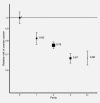Histological subtypes of ovarian cancer associated with parity and breastfeeding in the prospective Million Women Study
- PMID: 28929490
- PMCID: PMC5725697
- DOI: 10.1002/ijc.31063
Histological subtypes of ovarian cancer associated with parity and breastfeeding in the prospective Million Women Study
Abstract
Ovarian cancer risk is known to be reduced amongst women who have had children, but reported associations with breastfeeding are varied. Few studies have had sufficient power to explore reliably these associations by tumour histotype. In a prospective study of 1.1 million UK women, 8719 developed ovarian cancer during follow-up. Cox regression yielded adjusted relative risks (RRs) overall and by tumour histotype amongst women with different childbearing patterns. Nulliparous women had a 24% greater ovarian cancer risk than women with one child, with significant heterogeneity by histotype (p = 0.01). There was no significant increase in serous tumours, a modest increase in mucinous tumours, but a substantial increase in endometrioid (RR = 1.49, 95% CI: 1.18-1.89) and clear-cell tumours (RR = 1.68, 1.29-2.20). Among parous women, each additional birth was associated with an overall 6% reduction in ovarian cancer risk; this association also varied by histotype (p = 0.0006), with the largest reduction in risk for clear-cell tumours (RR per birth = 0.75, 0.65-0.85, p < 0.001) and weak, if any, effect for endometrioid, high-grade serous, or mucinous tumours. We found little association with age at first or last birth. There was about a 10% risk reduction per 12-months breastfeeding (RR = 0.89, 0.84-0.94, p < 0.001), with no significant heterogeneity by histotype, but statistical power was limited. In this large prospective study, ovarian cancer risk associated with parity varied substantially by tumour histotype. Nulliparity was associated with a substantially greater overall risk than expected from the effect of a single birth, especially for clear cell and endometrioid tumours, perhaps suggesting that infertility is associated with these histotypes.
Keywords: breastfeeding; histological type; ovarian cancer; parity; reproductive factors.
© 2017 The Authors International Journal of Cancer published by John Wiley & Sons Ltd on behalf of UICC.
Figures





References
-
- Adami HO, Hsieh CC, Lambe M, et al Parity, age at first childbirth, and risk of ovarian cancer. Lancet. 1994;344:1250–4. - PubMed
-
- Albrektsen G, Heuch I, Kvale G. Reproductive factors and incidence of epithelial ovarian cancer: a Norwegian prospective study. Cancer Causes Control. 1996;7:421–7. - PubMed
Publication types
MeSH terms
Grants and funding
LinkOut - more resources
Full Text Sources
Other Literature Sources
Medical

